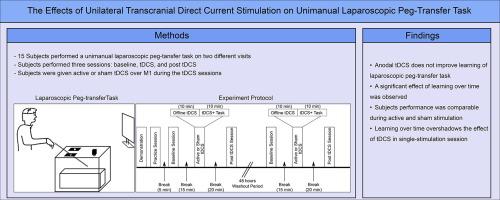Brain Research ( IF 2.9 ) Pub Date : 2021-09-08 , DOI: 10.1016/j.brainres.2021.147656 Zaeem Hadi 1 , Aysha Umbreen 2 , Muhammad Nabeel Anwar 2 , Muhammad Samran Navid 3

|
Introduction
Efficient training methods are required for laparoscopic surgical skills training to reduce the time needed for proficiency. Transcranial direct current stimulation (tDCS) is widely used to enhance motor skill acquisition and can be used to supplement the training of laparoscopic surgical skill acquisition. The aim of this study was to investigate the effect of anodal tDCS over the primary motor cortex (M1) on the performance of a unimanual variant of the laparoscopic peg-transfer task.
Methods
Fifteen healthy subjects participated in this randomized, double-blinded crossover study involving an anodal tDCS and a sham tDCS intervention separated by 48 h. On each intervention day, subjects performed a unimanual variant of laparoscopic peg-transfer task in three sessions (baseline, tDCS, post-tDCS). The tDCS session consisted of 10 min of offline tDCS followed by 10 min of online tDCS. The scores based on the task completion time and the number of errors in each session were used as a primary outcome measure. A linear mixed-effects model was used for the analysis.
Results
We found that the scores increased over sessions (p < 0.01). However, we found no effects of stimulation (anodal tDCS vs. sham tDCS) and no interaction of stimulation and sessions.
Conclusion
This study suggests that irrespective of the type of current stimulation (anodal and sham) over M1, there was an improvement in the performance of the unimanual peg-transfer task, implying that there was motor learning over time. The results would be useful in designing efficient training paradigms and further investigating the effects of tDCS on laparoscopic peg-transfer tasks.
中文翻译:

单侧经颅直流电刺激对单手腹腔镜钉转移任务的影响
介绍
腹腔镜手术技能培训需要有效的培训方法,以减少熟练所需的时间。经颅直流电刺激 (tDCS) 广泛用于增强运动技能习得,可用于补充腹腔镜手术技能习得的训练。本研究的目的是研究阳极 tDCS 在初级运动皮层 (M1) 上对腹腔镜钉转移任务的单手动变体性能的影响。
方法
15 名健康受试者参加了这项随机、双盲交叉研究,涉及间隔 48 小时的阳极 tDCS 和假 tDCS 干预。在每个干预日,受试者在三个会话(基线、tDCS、tDCS 后)中执行腹腔镜钉转移任务的单手变体。tDCS 会话由 10 分钟的离线 tDCS 和 10 分钟的在线 tDCS 组成。基于任务完成时间和每个会话中的错误数量的分数被用作主要结果衡量标准。使用线性混合效应模型进行分析。
结果
我们发现分数随着会话的增加而增加(p < 0.01)。然而,我们发现没有刺激的影响(阳极 tDCS 与假 tDCS),也没有刺激和会话的相互作用。
结论
这项研究表明,无论 M1 上的电流刺激类型(阳极和假刺激)如何,单手 peg-transfer 任务的性能都有所改善,这意味着随着时间的推移存在运动学习。该结果将有助于设计有效的训练范式和进一步研究 tDCS 对腹腔镜钉转移任务的影响。

























 京公网安备 11010802027423号
京公网安备 11010802027423号